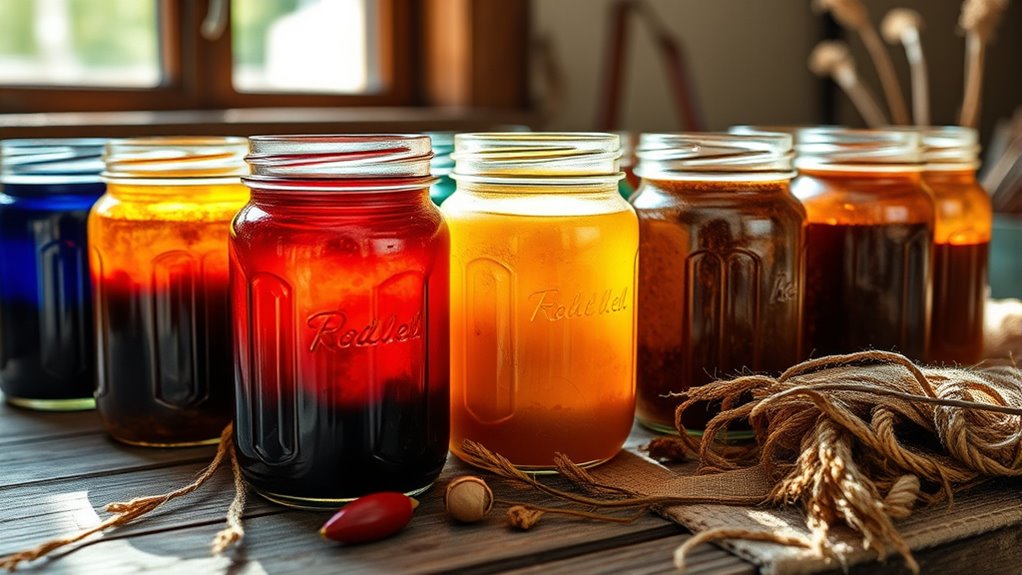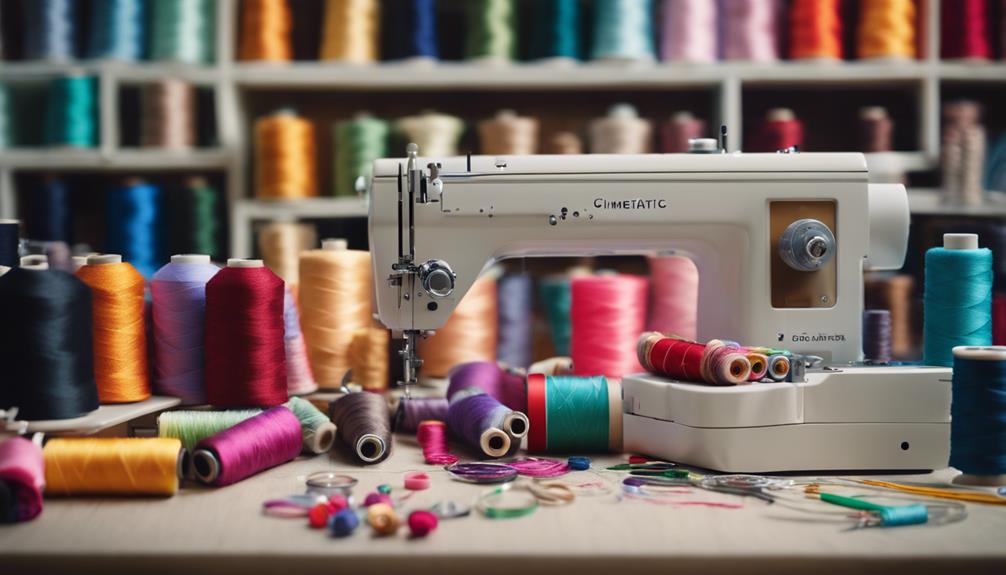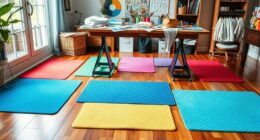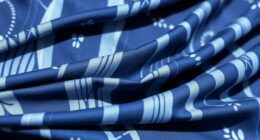If you’re exploring natural dyeing in 2025, I recommend trying out some top mordants like Jacquard Alum, MB Herbals Alum Powder, and Organic Cotton Plus Alum for vibrant, safe results. Natural options like oak gall powder also open up earthy shades. Each mordant has unique benefits, influencing color, fastness, and eco-friendliness. If you want to discover more about these essential products and how to use them, keep going—there’s plenty to learn.
Key Takeaways
- The list includes natural, eco-friendly alum mordants like oak gall, Aleppo galls, and plant-based options suitable for sustainable dyeing.
- It features versatile products such as Jacquard Alum and Organic Cotton Plus Alum for vibrant, consistent results.
- The best mordants improve dye fastness, enhance color vibrancy, and work well on natural fabrics like cotton, wool, and silk.
- The guide highlights benefits, application tips, safety precautions, and potential drawbacks of each mordant.
- Updated for 2025, it showcases trending natural mordants and pigments to expand your eco-dyeing palette.
Jacquard Alum 1lb Pkg for Marbling

If you’re into fabric marbling or natural dyeing, Jacquard Alum 1lb Pkg is an excellent choice because it’s highly pure and dissolves easily in hot water. I’ve used it for creating stunning marbled designs and it consistently delivers clear, vibrant results. The alum forms a supersaturated solution that’s essential for transferring intricate patterns onto fabric. Its quality is praised by many, with quick dissolving and minimal impurities. Plus, the 1-pound package lasts through numerous projects, making it a cost-effective option. Whether you’re a beginner or experienced artist, Jacquard Alum helps guarantee your marbling and dyeing projects turn out beautifully every time.
Best For: artists, crafters, and DIY enthusiasts engaged in fabric marbling, natural dyeing, or leather tanning seeking a high-purity, easy-to-dissolve alum powder for vibrant, consistent results.
Pros:
- High purity and quick dissolving in hot water, ensuring clear solutions for marbling and dyeing projects
- Versatile use across multiple applications including art, craft, tanning, and cleaning
- Large 1-pound package provides good value and lasts through numerous projects
Cons:
- Slightly higher price point compared to cheaper, lower-quality alum powders
- Potential for damaged packaging or product loss during shipping, as reported by some customers
- Requires careful handling and precise measurements to avoid impurities or incomplete dissolution
MB Herbals Alum Powder (100g)

MB Herbals Alum Powder (100g) stands out as an excellent choice for natural dye enthusiasts seeking a versatile, cosmetic-grade mordant. It’s suitable for fabric, leather, and paper treatments, making it a multi-purpose option. While primarily intended for external use like deodorants and skincare, it also effectively binds dyes to fibers. Keep in mind, the product is granulated and may require crushing for fine applications. Despite some texture inconsistencies and impurities reported by users, many find it affordable and reliable. Just remember to handle it carefully, avoid ingestion, and follow safety guidelines. It’s a practical, multifunctional alum that complements natural dyeing projects well.
Best For: natural dye enthusiasts, craft artisans, and those seeking a versatile, external-use alum for fabric, leather, paper, and gardening applications.
Pros:
- Eco-friendly, cosmetic-grade alum suitable for multiple external uses including dyeing and personal care.
- Affordable and widely available with positive feedback on effectiveness.
- Multi-purpose product that can be used as a mordant, deodorant, and soil pH balancer.
Cons:
- Granulated form may require crushing or grinding for fine applications.
- Inconsistencies in texture and reports of impurities can lead to milky solutions or require settling time.
- Not suitable for ingestion or food preparation, and should only be used externally or under professional supervision for water treatment.
Organic Cotton Plus Alum Mordant – Aluminum Sulfate – 1 Pound

Organic Cotton Plus Alum Mordant stands out as an ideal choice for natural dyeing enthusiasts seeking a non-iron, high-quality aluminum sulfate. This water-soluble, 100% iron-free alum is perfect for fixing dyes and enhancing color vibrancy on natural fibers like cotton. Packaged in a convenient 1-pound size, it dissolves quickly and delivers rich, fast results in fabric dyeing and eco-printing. Made in the USA, it’s versatile enough for water treatment, gardening, and paper manufacturing. With a strong customer rating of 4.8 stars, it’s a reliable, affordable option that supports eco-friendly crafting and dyeing projects with ease.
Best For: natural dyers, eco-printing enthusiasts, and gardeners seeking an iron-free, high-quality aluminum sulfate for dye fixing, water treatment, or soil pH adjustment.
Pros:
- 100% iron-free, making it suitable for sensitive dyeing projects and eco-friendly applications
- Dissolves quickly and easily, ensuring efficient use in fabric dyeing and eco-printing
- Versatile, with uses spanning dye fixation, water purification, paper manufacturing, and gardening
Cons:
- Requires careful handling and precise measurement to avoid over-application in gardening or water treatment
- May be less effective for dye fixation on synthetic fibers compared to other mordants
- Larger chunks may take longer to dissolve if not finely ground, potentially slowing down some applications
Natural Mordant for Natural Vegetable Dyes

Natural mordants like the one made from Aleppo Oak gallnuts are ideal for eco-conscious dyers seeking a sustainable way to enhance color fastness. I love using this powdered extract because it’s derived from nature and works perfectly with plant-based dyes like avocado pits. It fixates dyes on fibers such as cotton, making colors more vibrant and long-lasting. Just dissolve the powder in water and apply it before dyeing for best results. It’s a plant-based, eco-friendly alternative to synthetic mordants, supporting sustainable dyeing practices. I’ve found it reliable and effective, especially when working with natural fibers and vegetable dyes.
Best For: eco-conscious fiber artists and natural dyers seeking a sustainable, plant-based mordant to enhance dye fastness on fibers like cotton and wool.
Pros:
- 100% natural extract derived from Aleppo Oak gallnuts, making it eco-friendly and non-toxic
- Improves color fastness and dye adherence on natural fibers such as cotton and wool
- Easy to use—simply dissolve in water and apply before dyeing for best results
Cons:
- May require precise measurement and application to achieve optimal mordanting effects
- Limited to natural fibers and vegetable dyes; not suitable for synthetic fibers
- Slight variation in color hue (reddish-maroon) may affect certain dyeing projects
MB Herbals Alum Powder 8 oz

If you’re looking for a reliable alum powder for your dyeing projects, MB Herbals Alum Powder 8 oz is an excellent choice. Made from cosmetic-grade alum, it’s suitable for external applications like mordanting fabrics or using as a natural deodorant. I appreciate its versatility—it’s great for fabric, leather, or even as a preservative in cosmetics. Just remember, this alum is for external use only; always do a patch test before applying. Store it in a dry place, out of children’s reach, and follow the instructions carefully. Overall, it’s a dependable, multipurpose alum that fits seamlessly into natural dyeing processes.
Best For: crafters, natural dye enthusiasts, and DIY individuals seeking a versatile, cosmetic-grade alum for fabric mordanting, deodorizing, and cosmetic preservation.
Pros:
- Multipurpose use for fabric dyeing, deodorant, and cosmetic preservation
- Made from cosmetic-grade alum, ensuring safety and quality
- Easy to store and handle in a dry, child-proof environment
Cons:
- External use only; not suitable for internal consumption or water treatment by unqualified persons
- Must conduct a patch test to check for skin irritation before use
- Should be kept away from children and stored properly to maintain safety
Gall Powder from Oak Trees – Natural Textile Dye

Looking to achieve authentic, earthy tones in your textile projects? Gall Powder from oak trees, also called Spangle or Oak Gall, is a natural dye that can help you do just that. Made from dried galls harvested in Turkey, this beige powder contains no additives and is non-GMO. When used alone, it produces light beige shades, but combining it with iron afterbaths can create striking gray or black hues. It’s versatile, compatible with various materials, and perfect for those wanting a genuine, natural look. With a high customer rating, Gall Powder is a reliable choice for eco-conscious dyeing enthusiasts seeking rich, earthy colors.
Best For: eco-conscious textile artists and crafters seeking authentic, natural dyes for creating earthy-toned fabrics and artworks.
Pros:
- 100% natural, chemical-free, and non-GMO.
- Versatile application, producing a range of shades from light beige to black with iron afterbaths.
- High customer ratings indicate reliability and satisfaction.
Cons:
- Requires careful storage in dry, cool, dark conditions to maintain quality.
- The dyeing process may involve additional steps, such as iron afterbaths, for darker shades.
- Limited color palette compared to synthetic dyes, primarily earthy tones.
Organic Cotton Plus Soda Ash – 1 Pound

Organic Cotton Plus Soda Ash is an essential chemical for anyone involved in fiber dyeing or water treatment projects, thanks to its effectiveness as a dye fixative. It helps improve color bonding and enhances color fastness when dyeing cotton with fiber reactive dyes. I’ve found it particularly useful for ensuring vibrant, long-lasting results in my projects. Packaged in a convenient 1-pound size, it’s easy to handle and store. Made in the USA, this professional-grade soda ash also works well for correcting acidic water conditions in pools and spas by raising pH levels quickly. Its reliability has earned high praise from many users.
Best For: hobbyists and professionals involved in fiber dyeing, textile arts, and pool maintenance seeking a reliable, professional-grade soda ash for color fixation and water pH adjustment.
Pros:
- Enhances color fastness and bonding when dyeing cotton with fiber reactive dyes
- Effective in quickly raising pH levels for pool and spa water correction
- Made in the USA, ensuring quality and safety standards
Cons:
- Packaging may be limited to small 1-pound quantities, requiring multiple purchases for large projects
- Not suitable for use with non-cotton fibers without proper testing
- Requires careful handling and storage to avoid moisture absorption or spillage
Jacquard Products Soda Ash Dye Fixer, 1 Pound Bag

Jacquard Products Soda Ash Dye Fixer, 1 Pound Bag, is an excellent choice for anyone new to natural dyeing who wants vibrant, long-lasting colors. This dye activator guarantees Procion MX dyes bond permanently to natural fibers like cotton, linen, and rayon. It’s easy to use—simply dissolve in water and add to your dye bath or washing machine. The soda ash enhances color intensity and durability, making your projects resistant to fading. Available in convenient sizes, it’s perfect for both small and large projects. Quick to dissolve and reliable, it’s a favorite among hobbyists and professionals seeking consistent, vibrant results.
Best For: hobbyists and professional textile artists seeking an easy-to-use, reliable dye fixer for vibrant, durable natural fiber dyeing projects.
Pros:
- Ensures permanent bonding of Procion MX dyes to natural fibers, resulting in long-lasting colors
- Easy to dissolve and versatile, suitable for dye baths or washing machine application
- Available in multiple sizes, accommodating both small crafts and large-scale projects
Cons:
- Designed primarily for natural fibers; less effective on synthetic fabrics
- May require careful measurement to achieve optimal results for beginners
- Can be slightly dusty or clumpy if not stored properly
Marigold Extract Natural Dye, 1 oz.

If you’re seeking vibrant, natural yellow hues for your fabric projects, Marigold Extract Natural Dye, 1 oz., is an excellent choice. This extract contains all-natural Aztec Marigold blossom extract, perfect for dyeing wool and cotton. Use about 5% WOF to achieve deep sun yellow shades on well-mordanted fibers. You can also shift the color to olives or moss greens by adjusting the mordant. The 1-ounce size is sufficient for multiple projects, making it a versatile and cost-effective option. It produces strong, clear yellows and works well with natural fibers, giving you consistent, beautiful results every time.
Best For: crafters, textile artists, and DIY enthusiasts seeking natural, vibrant yellow dyes for wool and cotton fabrics.
Pros:
- Produces deep sun yellow hues with just 5% WOF usage
- All-natural Aztec Marigold blossom extract ensures eco-friendly dyeing
- Suitable for multiple projects, offering good value and consistent color results
Cons:
- Color can vary slightly depending on the mordant used, requiring experimentation
- Limited to natural fibers like wool and cotton; less effective on synthetic fabrics
- Requires proper mordanting process to achieve optimal dye results
Mi Nature Alum Powder Potassium Face Mask Powder (227g)

Mi Nature Alum Powder Potassium Face Mask Powder (227g) is an excellent choice for those seeking a versatile natural ingredient that combines skincare and household uses. It’s 100% pure, processed for high purity, and free from additives or fillers. In skincare, it acts as a natural astringent, tightening pores, reducing excess oil, and calming irritation—perfect after shaving or for facial care. Its powder form allows easy measurement and mixing for personalized solutions. Besides personal care, it’s been used for centuries in household tasks like water purification, fabric dyeing, and pickling. With its concentrated nature, it offers long-lasting value and multiple applications in both beauty and household routines.
Best For: individuals seeking a natural, multi-purpose powder for skincare, household cleaning, and traditional household uses.
Pros:
- 100% pure and free from additives, ensuring safe use in personal care and household applications.
- Versatile powder that can be easily mixed for customized skincare or household solutions.
- Long-lasting and economical, providing months of use across multiple purposes.
Cons:
- May require proper mixing and measurement for optimal results, which could be less convenient for quick applications.
- As a natural mineral, some users with sensitive skin might experience irritation if not properly diluted.
- The powder’s strong concentration may necessitate cautious handling to avoid overuse or mess during mixing.
The Modern Natural Dyer: Guide to Dyeing Silk, Wool, Linen & Cotton

For anyone interested in achieving vibrant, long-lasting colors on silk, wool, linen, or cotton, understanding the role of mordants is essential. The Modern Natural Dyer offers a beautifully organized guide, featuring stunning visuals and clear, step-by-step instructions that suit both beginners and experienced dyers. It covers dyeing techniques for various fibers, including detailed projects and recipes, while emphasizing natural dye processes. With cultural insights into traditional methods and all-encompassing troubleshooting tips, this book is a valuable resource. Its inspiring photography and practical guidance make it easier than ever to experiment confidently with natural dyes on different textiles.
Best For: hobbyists and artisans seeking a beautifully organized, comprehensive guide to natural dyeing techniques for silk, wool, linen, and cotton, with an emphasis on cultural context and practical project guidance.
Pros:
- Stunning visuals, detailed photographs, and well-organized layout enhance the learning experience.
- Clear, step-by-step instructions suitable for both beginners and experienced dyers.
- Rich cultural insights and historical context enrich understanding of natural dyeing traditions.
Cons:
- Limited coverage of advanced dyeing techniques for experienced practitioners.
- Some project options may be basic or geared toward beginner-level dyers.
- Focus primarily on traditional methods may limit exploration of regional plant sources or innovative approaches.
The Art and Craft of Natural Dyeing: Traditional Recipes for Modern Use

This book is an essential resource for experienced natural dyers who want to master the chemistry behind mordants and achieve consistent, vibrant results. I appreciate its detailed recipes and technical insights, which go beyond simple instructions. It covers dye sources, mordant chemistry, and specific procedures for various fibers like wool, cotton, and linen. The focus on understanding pH levels, temperatures, and chemical reactions helps me refine my techniques and troubleshoot challenges. While dense, the book’s exhaustive approach empowers serious dyers to adapt traditional recipes for modern use, ensuring beautiful, long-lasting colors with natural dyes.
Best For: Serious natural dyers and researchers seeking in-depth technical knowledge and reliable recipes for dyeing fibers with natural dyes.
Pros:
- Comprehensive coverage of dye chemistry, mordants, and fiber-specific techniques
- Detailed instructions on pH, temperature, and chemical reactions for consistent results
- Highly regarded as an authoritative, tested resource for advanced dyeing practices
Cons:
- Dense and technical content may be overwhelming for casual or beginner dyers
- Lacks visual images or photographs to illustrate techniques and results
- Use of American measurement units can be inconvenient for international readers
CopesFuda Eco Printing & Flower Pounding Kit for DIY Handbags and Crafts

The CopesFuda Eco Printing & Flower Pounding Kit is an excellent choice for anyone interested in exploring natural fabric arts, especially those who enjoy hands-on, eco-friendly crafting. It includes linen or cotton fabric, a rubber hammer, silicone pad, color fixative, embroidery hoop, and a canvas tote bag, making it versatile for creating botanical prints, plant rubbing, and shibori dyeing. The kit allows you to experiment with natural dyes from garden or kitchen plants, resulting in washable, durable artwork perfect for decorations or gifts. Ideal for beginners and experienced crafters alike, it promotes sustainable art while fostering creativity and a deeper connection to nature.
Best For: hobbyists, families, and eco-conscious crafters looking to create natural fabric art and botanical prints with sustainable materials.
Pros:
- Includes comprehensive tools and materials for versatile natural dyeing and pounding techniques
- Promotes environmental awareness and sustainability through eco-friendly processes
- Suitable for all skill levels, from beginners to experienced crafters, and great for family activities
Cons:
- Some users report muted colors for certain shades like pinks and purples
- The mallet may have residue, which could affect the cleanliness of craft projects
- Instructions could be clearer, especially for those new to natural dyeing and plant rubbing techniques
Lichen Dyes: The New Source Book (Dover Crafts: Weaving & Dyeing)

If you’re interested in exploring sustainable and traditional dyeing methods, Lichen Dyes: The New Source Book is an excellent resource, especially if you’re willing to investigate into the scientific and historical aspects of lichen dyes. This book offers detailed guidance on harvesting, preparing, and dyeing with lichens, emphasizing ethical collection to protect ecosystems. It covers various methods, including boiling, ammonia-based, and fermented techniques, some taking weeks. While it lacks photos for species identification, it provides extensive references, recipes, and cultural insights. Perfect for adventurous dyers, it promotes responsible use and deepens understanding of this unique, eco-friendly dye source.
Best For: adventurous natural dyers and researchers eager to explore the scientific, historical, and ethical aspects of lichen dyes, with a willingness to experiment and document their findings.
Pros:
- Comprehensive coverage of traditional and modern lichen dyeing techniques with detailed recipes and methods.
- Emphasis on sustainable, ethical harvesting practices that support ecological responsibility.
- Rich cultural and historical insights that deepen understanding of lichen dyeing across different regions.
Cons:
- Lacks photographs or visual aids for accurate wild identification of lichens.
- Assumes some prior knowledge of dyeing terminology, which may challenge beginners.
- Some dyeing methods require extended timeframes, up to 15 weeks, which may not suit quick projects.
Factors to Consider When Choosing Mordants for Natural Dyeing

When choosing a mordant, I consider how it will affect the dye color and how well it works with different fibers. I also look at how durable and fast the color will be over time, along with how easy the application process is. finally, I keep environmental sustainability in mind to make sure my dyeing practices are eco-friendly.
Dye Color Impact
Choosing the right mordant can substantially influence the final color of natural dyeing projects, as different mordants interact chemically with dyes to produce a range of hues. For example, alum enhances brightness, resulting in vibrant, true-to-source colors, while iron tends to darken or mute shades, creating gray, black, or deeper tones. Copper can introduce greenish or bluish tints, adding unique variations to your palette. The chemical interactions also affect color saturation and intensity—some mordants make colors more vivid, others dull or soften them. Additionally, warm-toned mordants shift hues toward reds and oranges, whereas cooler mordants lean toward blues and greens. Understanding these impacts allows me to intentionally select mordants that align with my desired final color, elevating my natural dyeing results.
Fiber Compatibility Needs
Selecting the right mordant depends heavily on the fiber type you’re working with, as different fibers interact uniquely with dye and mordants. Protein fibers like wool and silk usually respond well to alum or alum-based mordants, which boost color vibrancy and improve dye affinity. Plant fibers such as cotton and linen often require stronger mordants, like alum combined with tannins, to enhance dye uptake and durability. Some mordants are better suited for specific fibers because of their chemical interactions, influencing the final color and how well it lasts. It’s essential to verify compatibility before dyeing, as using incompatible mordants can cause uneven coloring, poor colorfastness, or even damage to the fibers. Knowing your fiber type helps guarantee optimal results in natural dyeing.
Fastness and Durability
The durability and fastness of natural dyes largely depend on the mordant used, as it determines how well the color withstands fading from washing, sunlight, and environmental exposure. Some mordants, like alum, provide excellent light and wash fastness, helping colors stay vibrant over time. Others, such as iron, may darken or shift hues and can weaken the bond between dye and fiber, reducing longevity. The chemical strength of the mordant’s bond with the fiber influences durability, with stronger bonds resisting fading better. Additionally, the pH level of the mordant solution affects dye adherence; certain pH ranges enhance color stability. Choosing a mordant that forms a stable chemical bond and suits your fabric ensures your natural-dyed textiles maintain their beauty and resist wear longer.
Environmental Sustainability
When considering mordants for natural dyeing, prioritizing environmental sustainability is essential to minimize ecological impact. I look for mordants with low environmental footprints, like alum or plant-based options, to reduce pollution and conserve resources. Sourcing mordants from sustainably harvested or local materials helps prevent ecological disruption and supports conservation efforts. I also choose non-toxic, biodegradable mordants to ensure that wastewater and residues don’t harm aquatic life or soil health. Minimizing processing and energy use in manufacturing reduces carbon emissions, making the dyeing process greener. Additionally, I prefer mordants with well-documented safe disposal methods to prevent harmful chemicals from accumulating in ecosystems. Prioritizing these factors allows me to create beautiful dyes responsibly, with a lighter impact on our planet.
Application Method Ease
Choosing an application method for mordants can considerably influence the ease and success of natural dyeing projects. Mordants that dissolve quickly in water, like liquid or pre-mixed options, make application simple through immersion or brushing, saving time and effort. These are especially beginner-friendly, as they eliminate the need for grinding or measuring powders. Powdered mordants, on the other hand, often require dissolving in hot water, which can be tricky for newcomers. Some mordants can be sprayed or painted directly onto fibers, offering precise control and making detailed work easier. The viscosity and consistency of the mordant solution also matter; thinner solutions spread more evenly, simplifying the process. Overall, choosing an application method that suits your skill level and project needs makes natural dyeing more accessible and enjoyable.
Cost and Availability
Cost and availability are key factors I consider when selecting mordants for natural dyeing, since they directly affect my project budget and planning. Natural mordants like alum are generally affordable and easy to find, making them a practical choice. However, specialty mordants can be more expensive and might require sourcing from specific suppliers, which can increase costs and complicate procurement. The availability of mordants varies depending on local suppliers and online markets; common options are usually accessible, but rare materials might be harder to find or pricier. When working with larger quantities or multiple mordants, costs can add up quickly, so I always check the supply and price beforehand. Ensuring I can reliably source my preferred mordants helps keep my projects on track financially.
Toxicity and Safety
Toxicity and safety are critical considerations because some mordants, like chromium or arsenic-based compounds, pose significant health risks if mishandled. These heavy metal mordants can cause skin irritation, respiratory issues, and environmental contamination if not used properly. Handling them requires protective gear such as gloves and masks, and working in well-ventilated areas to reduce inhalation or skin contact. For safer projects, especially involving children, household use, or eco-friendly practices, choosing non-toxic or natural mordants is highly recommended. Proper disposal is also essential to prevent environmental pollution, as some chemical mordants can persist and accumulate in ecosystems. Prioritizing safety ensures both personal health and environmental protection during natural dyeing processes.
Cultural and Traditional Use
When selecting mordants for natural dyeing, it’s important to contemplate their cultural and traditional significance. Many cultures have historically used specific mordants, like alum in European textiles or iron in Asian dyeing practices, which reflect local resources and aesthetic preferences. Indigenous techniques often rely on naturally available mordants that influence the final color and fabric qualities. For example, oak gall has been valued in European medieval dyeing and manuscript ink, symbolizing cultural heritage. Understanding these traditional uses helps me choose mordants that honor historical practices and maintain cultural authenticity. Recognizing the cultural context behind mordant choices enriches the dyeing process, connecting me to a broader tradition of craftsmanship and respecting the heritage embedded in textile artistry.
Frequently Asked Questions
Which Mordant Is Safest for Sensitive Skin and Eco-Friendly?
If you’re concerned about sensitive skin and want an eco-friendly mordant, I recommend alum (potassium aluminum sulfate). It’s generally safe, non-toxic, and widely used in natural dyeing. I always make sure to use food-grade alum, which is gentle and suitable for delicate skin. Plus, it’s biodegradable and environmentally friendly. Just remember to handle it with care and rinse thoroughly after mordanting to keep your dyes vibrant and safe.
How Do Mordants Affect the Colorfastness of Natural Dyes?
Think of mordants as the sturdy roots anchoring a plant’s vibrant bloom. They notably enhance the colorfastness of natural dyes by forming a chemical bond with the fibers, much like roots locking nutrients in soil. Without this anchor, colors can fade or bleed over time. So, using the right mordant guarantees your dye’s brilliance stays vivid and resilient through repeated washes, just like deep roots keep a plant thriving.
Can Multiple Mordants Be Used Together for Unique Shades?
Yes, I often use multiple mordants together to create unique shades in natural dyeing. Combining mordants like alum and iron, for example, can deepen or alter colors, giving me more control over the final hue. I experiment with different combinations to achieve interesting effects. Just remember, some mordants can react unpredictably, so I recommend testing small samples first to see how the colors develop.
What Is the Best Way to Store Leftover Mordants?
I store leftover mordants in airtight glass jars to keep them dry and prevent contamination. I label each jar clearly and keep them in a cool, dark place to preserve their effectiveness. Before sealing, I guarantee the mordants are completely cooled and dry. This method helps me reuse them safely for future projects, reducing waste and saving money while maintaining their potency for vibrant, lasting colors.
Are There Natural Alternatives to Traditional Mordants?
Yes, there are natural alternatives to traditional mordants. I often use alum, which is relatively gentle and plant-based, or tannins from tea, pomegranate, or oak galls, which naturally enhance dye affinity. Additionally, alum-derivatives like cream of tartar or iron salts can sometimes be substituted with natural sources. I recommend experimenting with these options, as they’re eco-friendly and can give beautiful, varied results in your dye projects.
Conclusion
Choosing the right mordant is like selecting the perfect key to open a treasure chest of vibrant hues. With these top options, you hold the map to dyeing success, each one revealing doors to unique shades and textures. Immerse yourself with curiosity and confidence—your natural dyeing journey is a vibrant adventure waiting to unfold. Let these mordants be your trusted guides as you paint your world with the colors of nature.










